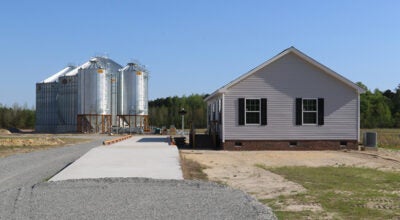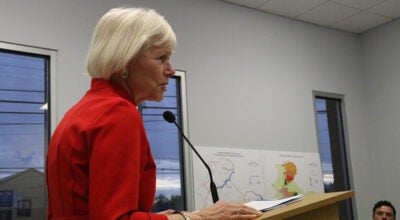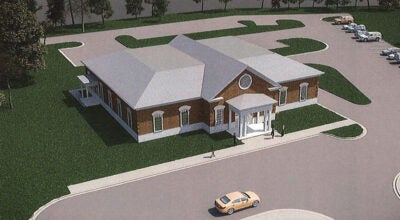Camp Community College plans $3.6M sports complex
Published 4:30 pm Friday, August 9, 2019

- Camp Community College President Dr. Dan Lufkin presented this architectural rendering of a proposed $3.6 million sports complex at the college to Franklin’s City Council on Monday, July 29.
|
Getting your Trinity Audio player ready...
|
FRANKLIN
Camp Community College hopes to construct a $3.6 million sports complex at its Franklin campus within the next two years.
According to plans designed by the architectural firm Kimley-Horn — which is the same firm that designed the town of Smithfield’s recently-completed Luter Sports Complex — the proposed Camp Community College complex will include the existing baseball field that serves as the home of the college’s Hurricanes baseball team, and would add a second baseball field, a softball field and men’s and women’s soccer fields. The new softball field would replace Armory Park as the home of the college’s Lady Hurricanes softball team, which made its debut in 2018. The new soccer fields will serve as the home of the college’s Hurricanes and Lady Hurricanes soccer teams, which will debut this fall.
College President Dr. Dan Lufkin confirmed that each field would be designed to meet current college and professional field dimensions.
According to an economic impact analysis Lufkin presented to Franklin’s City Council on July 22, the addition of men’s and women’s soccer this fall, combined with the college’s existing baseball and softball teams, is projected to bring a total of 120 student athletes to Camp Community College. The college’s goal in adding to its athletic program and upgrading and expanding its athletic facilities, Lufkin said, is “keeping our students local.”
“If we don’t have adequate facilities here, they’re [college students] going to go somewhere with adequate facilities,” he said. “We’re going to try to keep them in Franklin … 40 percent of that 120 are students, I can almost say, probably would not have come to Camp Community College otherwise if we did not have athletics.”
Of the 120 student athletes projected for the college’s fall 2019 semester, 104 are expected to reside within the Western Tidewater region. Of the 104, 38 are expected to already live within the region and 66 are expected to relocate to the area. According to the college’s economic impact analysis, each of the 104 in-area students is expected to spend a total of $12,200 annually (not including tuition, books or school supplies) for housing, meals, transportation and other personal expenses — resulting in roughly $1.26 million in off-campus spending each year.
The college president added that if other community college sports teams are going to travel across the country to play the Hurricanes, “They’re going to want to play in nice facilities.” The economic impact analysis estimates 1,200 visitors traveling to Franklin annually to watch or participate in the college’s 48 games per year, resulting in another $105,000 in annual spending for accommodations, meals and transportation.
Lufkin plans to return to the City Council at a later date to request funding for the proposed sports complex. The men’s and women’s soccer teams that will debut this fall will play at Nike Park in Carrollton and the Otelia J. Rainey Center in the Camptown area of Isle of Wight County until such time as the on-campus men’s and women’s soccer fields are completed.
“Eventually, we would like to see the city make an investment in the project, given the economic impact the complex will have on the city and local region,” he said. “An exact amount has yet to be determined. The college is still working on a budget and analyzing all available resources.”
Lufkin added that the college’s existing partnership with the city of Franklin to use the softball field at Armory Park, combined with the new fields planned, would give the college a total of three fields to host adult, high school and college tournaments. This too would bring in revenue for the college and the city.
Following Lufkin’s presentation to the City Council, Councilman Greg McLemore asked about the possibility of adding a basketball program. Lufkin said the reason the college was not pursuing basketball at this time was due to the cost of constructing a basketball gym and the difficulty that would likely occur in scheduling practices and games, were the college to try to partner with one of the area’s local high schools to use their courts.





